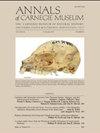来自美国犹他州熊耳国家纪念碑哈尔盖托地层的新石炭纪上层荒原龙(爬行动物门:穴居类)--哈尔盖托龙(Halgaitosaurus gregarius
IF 0.9
4区 地球科学
Q4 PALEONTOLOGY
引用次数: 0
摘要
ABSTRACT Halgaitosaurus gregarius is araeoscelidian diapsid reptile的一个新属和新种,其依据是来自美国犹他州熊耳国家纪念碑众神之谷哈尔盖托地层上石炭统(维吉尔统、格哲勒统)生日骨床的大量标本。哈尔盖特龙从幼年到完全骨化的成年标本代表了一个本生代系列。哈尔盖特龙与其他荒原龙的区别在于上颌牙齿的相对大小、颈骨对头骨腹缘的贡献较小以及八个颈椎。系统发生学分析表明,哈尔盖特龙和Araeoscelis Williston(威利斯顿,1910年)在单系Araeoscelidia中形成一个支系,Petrolacosaurus Lane(莱恩,1945年)和Zarcasaurus Brinkman, Berman, and Eberth(布林克曼,伯曼和埃伯斯,1984年)是这个支系的连续姐妹类群。在相对较短的时期内,当半干旱到干旱的气候条件下,间歇性到可能常年性的溪流和河流横穿泛大陆西部帕拉多克斯盆地西南边界的沿海平原时,哈尔盖特龙是脊椎动物群中的一个重要组成部分。本文章由计算机程序翻译,如有差异,请以英文原文为准。
Halgaitosaurus gregarius, a New Upper Carboniferous Araeoscelidian (Reptilia: Diapsida) from the Halgaito Formation, Bears Ears National Monument, Utah, USA
ABSTRACT Halgaitosaurus gregarius is a new genus and species of araeoscelidian diapsid reptile based on numerous specimens from the Upper Carboniferous (Virgilian, Gzhelian) Birthday bonebed, Halgaito Formation, Valley of the Gods, Bears Ears National Monument, Utah, USA. An ontogenetic series is represented by juvenile to fully ossified adult specimens. halgaitosaurus gregarius is distinguished from other araeoscelidians by relative sizes of maxillary teeth, a small contribution of the jugal to the ventral margin of the skull, and eight cervical vertebrae. A phylogenetic analysis suggests that halgaitosaurus and Araeoscelis Williston, 1910, form a clade in a monophyletic Araeoscelidia, with Petrolacosaurus Lane, 1945, and Zarcasaurus Brinkman, Berman, and Eberth, 1984, forming successive sister taxa to this clade. Spinoaequalis deBraga and Reisz, 1995, places as a member of Neodiapsida. halgaitosaurus was an abundant component of the vertebrate fauna that inhabited the coastal plain on the southwestern border of the Paradox Basin in western Pangea during a relatively short period when intermittent to probable perennial streams and rivers traversed it during an otherwise semi-arid to arid climate.
求助全文
通过发布文献求助,成功后即可免费获取论文全文。
去求助
来源期刊

Annals of Carnegie Museum
综合性期刊-动物学
CiteScore
2.50
自引率
18.20%
发文量
4
审稿时长
>12 weeks
期刊介绍:
Annals of Carnegie Museum is a quarterly journal that publishes peer-reviewed short and medium-length original scientific contributions in organismal biology, earth sciences, and anthropology, in 40 by 52.5 pica format (168 by 220 mm or 6-5/8 by 8-5/8 inches). Subject matter must be relevant to Carnegie Museum of Natural History scientific sections or Powdermill Nature Reserve (PNR), preferably with connection to the Carnegie collection and/or personnel. Carnegie Museum staff and research associates receive publication priority, but others are encouraged to submit papers, especially those manuscripts explicitly based on the Carnegie collection.
 求助内容:
求助内容: 应助结果提醒方式:
应助结果提醒方式:


